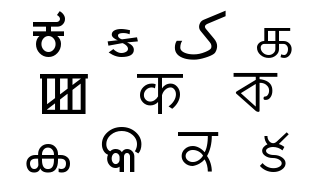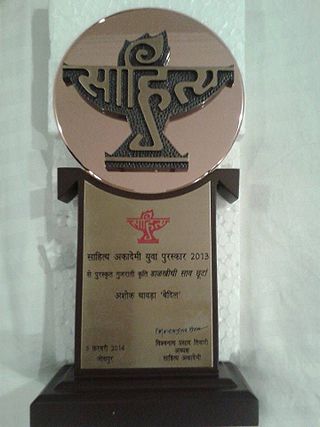
Devanagari is an Indic script used in the Indian subcontinent. Also simply called Nāgari, it is a left-to-right abugida, based on the ancient Brāhmi script. It is one of the official scripts of the Republic of India and Nepal. It was developed and in regular use by the 8th century CE and achieved its modern form by 1000 CE. The Devanāgari script, composed of 48 primary characters, including 14 vowels and 34 consonants, is the fourth most widely adopted writing system in the world, being used for over 120 languages.

The Brahmic scripts, also known as Indic scripts, are a family of abugida writing systems. They are used throughout the Indian subcontinent, Southeast Asia and parts of East Asia. They are descended from the Brahmi script of ancient India and are used by various languages in several language families in South, East and Southeast Asia: Indo-Aryan, Dravidian, Tibeto-Burman, Mongolic, Austroasiatic, Austronesian, and Tai. They were also the source of the dictionary order (gojūon) of Japanese kana.

Languages spoken in the Republic of India belong to several language families, the major ones being the Indo-Aryan languages spoken by 78.05% of Indians and the Dravidian languages spoken by 19.64% of Indians; both families together are sometimes known as Indic languages. Languages spoken by the remaining 2.31% of the population belong to the Austroasiatic, Sino–Tibetan, Tai–Kadai, and a few other minor language families and isolates. According to the People's Linguistic Survey of India, India has the second highest number of languages (780), after Papua New Guinea (840). Ethnologue lists a lower number of 456.
Indian Standard Code for Information Interchange (ISCII) is a coding scheme for representing various writing systems of India. It encodes the main Indic scripts and a Roman transliteration. The supported scripts are: Bengali–Assamese, Devanagari, Gujarati, Gurmukhi, Kannada, Malayalam, Oriya, Tamil, and Telugu. ISCII does not encode the writing systems of India that are based on Persian, but its writing system switching codes nonetheless provide for Kashmiri, Sindhi, Urdu, Persian, Pashto and Arabic. The Persian-based writing systems were subsequently encoded in the PASCII encoding.
The International Alphabet of Sanskrit Transliteration (IAST) is a transliteration scheme that allows the lossless romanisation of Indic scripts as employed by Sanskrit and related Indic languages. It is based on a scheme that emerged during the 19th century from suggestions by Charles Trevelyan, William Jones, Monier Monier-Williams and other scholars, and formalised by the Transliteration Committee of the Geneva Oriental Congress, in September 1894. IAST makes it possible for the reader to read the Indic text unambiguously, exactly as if it were in the original Indic script. It is this faithfulness to the original scripts that accounts for its continuing popularity amongst scholars.

Meitei also known as Manipuri, is a Tibeto-Burman language of northeast India. It is the official language and the lingua franca of Manipur and an additional official language in four districts of Assam. It is one of the constitutionally scheduled official languages of the Indian Republic. Meitei is the most widely-spoken Tibeto-Burman language of India and the third most widely spoken language of northeast India after Assamese and Bengali. There are 1.76 million Meitei native speakers in India according to the 2011 census, 1.52 million of whom are found in the state of Manipur, where they represent the majority of its population. There are smaller communities in neighbouring Indian states, such as Assam (168,000), Tripura (24,000), Nagaland (9,500), and elsewhere in the country (37,500). The language is also spoken by smaller groups in neighbouring Myanmar and Bangladesh.
An official script is a writing system that is specifically designated to be official in the constitutions or other applicable laws of countries, states, and other jurisdictions. Akin to an official language, an official script is much rarer. It is used primarily where an official language is in practice written with two or more scripts. As, in these languages, use of script often has cultural or political connotations, proclamation of an official script is sometimes criticized as having a goal of influencing culture or politics or both. Desired effects also may include easing education, communication and some other aspects of life.

The Meitei script, also known as the Kanglei script or the Kok Sam Lai script, after its first three letters is an abugida in the Brahmic scripts family used to write the Meitei language, the official language of Manipur, Assam and one of the 22 official languages of India. It is first known from engravings on 6th century CE coins and copper plate inscriptions. as verified by the various publications of the National Sahitya Akademi. It was used until the 18th century, when it was replaced by the Bengali alphabet. A few manuscripts survive. In the 20th century, the script was revived and is again being used. Beginning in 2021, the Government of Manipur began to use the Meitei alongside the Bengali-Assamese script, per the Manipur Official Language (Amendment) Act, 2021.

The Bengali–Assamese script, sometimes also known as Eastern Nagari, is an eastern Brahmic script, primarily used today for the Bengali and Assamese language spoken in eastern South Asia. It evolved from Gaudi script, also the common ancestor of the Odia and Trihuta scripts. It is commonly referred to as the Bengali script by Bengalis and the Assamese script by the Assamese, while in academic discourse it is sometimes called Eastern-Nāgarī. Three of the 22 official languages of the Indian Republic—Bengali, Assamese, and Meitei—commonly use this script in writing; Bengali is also the official and national language of Bangladesh.

Lists of Sahitya Akademi Award winners cover winners of the Sahitya Akademi Award, a literary honor in India which Sahitya Akademi, India's National Academy of Letters, annually confers on writers of outstanding works in one of the twenty-four major Indian languages. The lists are organized by language.

Vikaspedia is an online information guide launched by the Government of India. The website was implemented by C-DAC Hyderabad and is run by the Department of Electronics and Information Technology, Ministry of Communications and Information Technology. It is built as a portal for the social sectors, and offers information in 23 languages: English, Assamese, Telugu, Hindi, Bengali, Gujarati, Kannada, Malayalam, Tamil, Bodo, Dogri, Sanskrit, Kashmiri, Konkani, Nepali, Odia, Urdu, Maithili, Meitei, Santali, Sindhi, Punjabi, and Marathi.
The Eighth Schedule to the Constitution of India lists the languages officially recognized by the Government of India. As of 2024, 22 languages have been classified under the schedule.

The Yuva Puraskar, also known as Sahitya Akademi Yuva Puraskar, is a literary honor in India which Sahitya Akademi, India's National Academy of Letters, annually confers on young writers of outstanding works in one of the 24 major Indian languages. Instituted in 2011, it recognises young writers under 35, with the aim of encouraging and promoting young writers. It comprises a cash prize of Rs. 50,000 and an engraved copper plaque.
Modern Indian language (MIL) is a term used in India to denote several Indian languages used in modern times, with or without official status. Though most Modern Indian languages are also mentioned in Eighth Schedule to the Constitution of India, it is not necessary that all languages listed in either of them is listed in other one.

Directorate of Language Planning and Implementation (DLPI) is a directorate of the Government of Manipur in charge of the language planning and the implementation of language policy.

The social movement of Meitei language to attain linguistic purism is advocated by literary, political, social associations and organisations as well as notable individual personalities of Bangladesh, Myanmar and Northeast India.

The Naoriya Phulo script, also known as the Naoria script, the Invented Meitei Yelhou Mayek script, or the Invented Meetei Yelhou Mayek script, is a constructed script, invented by Laininghan Naoriya Phulo (1888-1941), to write Meitei language. It is different from the Meitei Mayek, the official script for Meitei language. It shares many similarities with the Devanagari script and the Eastern Nagari script.

The Bal Sahitya Puraskar also known as Sahitya Akademi Bal Sahitya Puraskar,is a literary honour in India, which the Sahitya Akademi, India's National Academy of Letters, annually confers on writers for their contribution in the field of Children's literature in any of the 22 languages of the 8th Schedule to the Indian constitution as well as in English and Rajasthani language. Instituted in 2010, it comprises a cash prize of Rs. 50,000 and an engraved copper plaque.

2022 in Meitei culture, including but not limited to Meitei architecture, Meitei cinema, Meitei cuisine, Meitei dances, Meitei festivals, Meitei language, Meitei literature, Meitei music, Meitei religion, Meitei script, etc.

Meetei Erol Eyek Loinasillol Apunba Lup, shortly known as the MEELAL, is a group that works for the development of Meitei language and Meitei script. It is one of the groups that spearhead the historic Meitei script movement against the Government of Manipur.


















